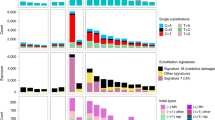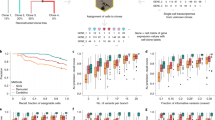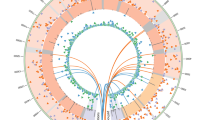Abstract
Reprogramming somatic cells into induced pluripotent stem cells (iPSCs) has been suspected of causing de novo copy number variation1,2,3,4. To explore this issue, here we perform a whole-genome and transcriptome analysis of 20 human iPSC lines derived from the primary skin fibroblasts of seven individuals using next-generation sequencing. We find that, on average, an iPSC line manifests two copy number variants (CNVs) not apparent in the fibroblasts from which the iPSC was derived. Using PCR and digital droplet PCR, we show that at least 50% of those CNVs are present as low-frequency somatic genomic variants in parental fibroblasts (that is, the fibroblasts from which each corresponding human iPSC line is derived), and are manifested in iPSC lines owing to their clonal origin. Hence, reprogramming does not necessarily lead to de novo CNVs in iPSCs, because most of the line-manifested CNVs reflect somatic mosaicism in the human skin. Moreover, our findings demonstrate that clonal expansion, and iPSC lines in particular, can be used as a discovery tool to reliably detect low-frequency CNVs in the tissue of origin. Overall, we estimate that approximately 30% of the fibroblast cells have somatic CNVs in their genomes, suggesting widespread somatic mosaicism in the human body. Our study paves the way to understanding the fundamental question of the extent to which cells of the human body normally acquire structural alterations in their DNA post-zygotically.
This is a preview of subscription content, access via your institution
Access options
Subscribe to this journal
Receive 51 print issues and online access
$199.00 per year
only $3.90 per issue
Buy this article
- Purchase on Springer Link
- Instant access to full article PDF
Prices may be subject to local taxes which are calculated during checkout


Similar content being viewed by others
Accession codes
Primary accessions
Gene Expression Omnibus
Data deposits
The CNV array and sequencing data are available from Gene Expression Omnibus under accessions GSE41716 and GSE41563, and from https://ndarportal.nih.gov/ndarportal/NDARSTD289.
References
Laurent, L. C. et al. Dynamic changes in the copy number of pluripotency and cell proliferation genes in human ESCs and iPSCs during reprogramming and time in culture. Cell Stem Cell 8, 106–118 (2011)
Quinlan, A. R. et al. Genome sequencing of mouse induced pluripotent stem cells reveals retroelement stability and infrequent DNA rearrangement during reprogramming. Cell Stem Cell 9, 366–373 (2011)
Hussein, S. M. et al. Copy number variation and selection during reprogramming to pluripotency. Nature 471, 58–62 (2011)
Mayshar, Y. et al. Identification and classification of chromosomal aberrations in human induced pluripotent stem cells. Cell Stem Cell 7, 521–531 (2010)
Takahashi, K. et al. Induction of pluripotent stem cells from adult human fibroblasts by defined factors. Cell 131, 861–872 (2007)
Yu, J. et al. Induced pluripotent stem cell lines derived from human somatic cells. Science 318, 1917–1920 (2007)
Wernig, M. et al. In vitro reprogramming of fibroblasts into a pluripotent ES-cell-like state. Nature 448, 318–324 (2007)
Lowry, W. E. et al. Generation of human induced pluripotent stem cells from dermal fibroblasts. Proc. Natl Acad. Sci. USA 105, 2883–2888 (2008)
Vaccarino, F. M. et al. Annual Research Review: the promise of stem cell research for neuropsychiatric disorders. J. Child Psychol. Psychiatry 52, 504–516 (2011)
Park, I. H. et al. Disease-specific induced pluripotent stem cells. Cell 134, 877–886 (2008)
Lee, G. et al. Modelling pathogenesis and treatment of familial dysautonomia using patient-specific iPSCs. Nature 461, 402–406 (2009)
Hargus, G. et al. Differentiated Parkinson patient-derived induced pluripotent stem cells grow in the adult rodent brain and reduce motor asymmetry in Parkinsonian rats. Proc. Natl Acad. Sci. USA 107, 15921–15926 (2010)
Brennand, K. J. & Gage, F. H. Concise review: the promise of human induced pluripotent stem cell-based studies of schizophrenia. Stem Cells 29, 1915–1922 (2011)
Liang, Q., Conte, N., Skarnes, W. C. & Bradley, A. Extensive genomic copy number variation in embryonic stem cells. Proc. Natl Acad. Sci. USA 105, 17453–17456 (2008)
Wu, H. et al. Copy number variant analysis of human embryonic stem cells. Stem Cells 26, 1484–1489 (2008)
Elliott, A. M., Elliott, K. A. & Kammesheidt, A. High resolution array-CGH characterization of human stem cells using a stem cell focused microarray. Mol. Biotechnol. 46, 234–242 (2010)
O’Huallachain, M., Karczewski, K. J., Weissman, S. M., Urban, A. E. & Snyder, M. P. Extensive genetic variation in somatic human tissues. Proc. Natl Acad. Sci.. USA http://dx.doi.org/10.1073/pnas.1213736109 (5 October 2012)
De, S. Somatic mosaicism in healthy human tissues. Trends Genet. 27, 217–223 (2011)
Baillie, J. K. et al. Somatic retrotransposition alters the genetic landscape of the human brain. Nature 479, 534–537 (2011)
Coufal, N. G. et al. L1 retrotransposition in human neural progenitor cells. Nature 460, 1127–1131 (2009)
Rehen, S. K. et al. Constitutional aneuploidy in the normal human brain. J. Neurosci. 25, 2176–2180 (2005)
Youssoufian, H. & Pyeritz, R. E. Mechanisms and consequences of somatic mosaicism in humans. Nature Rev. Genet. 3, 748–758 (2002)
Piotrowski, A. et al. Somatic mosaicism for copy number variation in differentiated human tissues. Hum. Mutat. 29, 1118–1124 (2008)
Mkrtchyan, H. et al. Early embryonic chromosome instability results in stable mosaic pattern in human tissues. PLoS ONE 5, e9591 (2010)
Poduri, A. et al. Somatic activation of AKT3 causes hemispheric developmental brain malformations. Neuron 74, 41–48 (2012)
Abyzov, A., Urban, A. E., Snyder, M. & Gerstein, M. CNVnator: an approach to discover, genotype, and characterize typical and atypical CNVs from family and population genome sequencing. Genome Res. 21, 974–984 (2011)
Mills, R. E. et al. Mapping copy number variation by population-scale genome sequencing. Nature 470, 59–65 (2011)
Cheng, L. et al. Low incidence of DNA sequence variation in human induced pluripotent stem cells generated by nonintegrating plasmid expression. Cell Stem Cell 10, 337–344 (2012)
Arlt, M. F., Ozdemir, A. C., Birkeland, S. R., Wilson, T. E. & Glover, T. W. Hydroxyurea induces de novo copy number variants in human cells. Proc. Natl Acad. Sci. USA 108, 17360–17365 (2011)
Eichler, E. E. et al. Missing heritability and strategies for finding the underlying causes of complex disease. Nature Rev. Genet. 11, 446–450 (2010)
Chan, E. M. et al. Live cell imaging distinguishes bona fide human iPS cells from partially reprogrammed cells. Nature Biotechnol. 27, 1033–1037 (2009)
Deb-Rinker, P., Ly, D., Jezierski, A., Sikorska, M. & Walker, P. R. Sequential DNA methylation of the Nanog and Oct-4 upstream regions in human NT2 cells during neuronal differentiation. J. Biol. Chem. 280, 6257–6260 (2005)
Freberg, C. T., Dahl, J. A., Timoskainen, S. & Collas, P. Epigenetic reprogramming of OCT4 and NANOG regulatory regions by embryonal carcinoma cell extract. Mol. Biol. Cell 18, 1543–1553 (2007)
Kim, J. E. et al. Investigating synapse formation and function using human pluripotent stem cell-derived neurons. Proc. Natl Acad. Sci. USA 108, 3005–3010 (2011)
Li, H. & Durbin, R. Fast and accurate long-read alignment with Burrows–Wheeler transform. Bioinformatics 26, 589–595 (2010)
Wang, L. Y., Abyzov, A., Korbel, J. O., Snyder, M. & Gerstein, M. MSB: a mean-shift-based approach for the analysis of structural variation in the genome. Genome Res. 19, 106–117 (2009)
Zhang, J., Feuk, L., Duggan, G. E., Khaja, R. & Scherer, S. W. Development of bioinformatics resources for display and analysis of copy number and other structural variants in the human genome. Cytogenet. Genome Res. 115, 205–214 (2006)
Korbel, J. O. et al. PEMer: a computational framework with simulation-based error models for inferring genomic structural variants from massive paired-end sequencing data. Genome Biol. 10, R23 (2009)
Lam, H. Y. et al. Nucleotide-resolution analysis of structural variants using BreakSeq and a breakpoint library. Nature Biotechnol. 28, 47–55 (2010)
Sanders, S. J. et al. Multiple recurrent de novo CNVs, including duplications of the 7q11.23 Williams syndrome region, are strongly associated with autism. Neuron 70, 863–885 (2011)
Qin, J., Jones, R. C. & Ramakrishnan, R. Studying copy number variations using a nanofluidic platform. Nucleic Acids Res. 36, e116 (2008)
Trapnell, C., Pachter, L. & Salzberg, S. L. TopHat: discovering splice junctions with RNA-Seq. Bioinformatics 25, 1105–1111 (2009)
Li, H. et al. The Sequence Alignment/Map format and SAMtools. Bioinformatics 25, 2078–2079 (2009)
Habegger, L. et al. RSEQtools: a modular framework to analyze RNA-Seq data using compact, anonymized data summaries. Bioinformatics 27, 281–283 (2011)
The ENCODE Project Consortium. An integrated encyclopedia of DNA elements in the human genome. Nature 489, 57–74 (2012)
Abyzov, A. & Gerstein, M. AGE: defining breakpoints of genomic structural variants at single-nucleotide resolution, through optimal alignments with gap excision. Bioinformatics 27, 595–603 (2011)
Hindson, B. J. et al. High-throughput droplet digital PCR system for absolute quantitation of DNA copy number. Anal. Chem. 83, 8604–8610 (2011)
Haraksingh, R. R., Abyzov, A., Gerstein, M., Urban, A. E. & Snyder, M. Genome-wide mapping of copy number variation in humans: comparative analysis of high resolution array platforms. PLoS ONE 6, e27859 (2011)
Acknowledgements
We acknowledge support from the National Institutes of Health (NIH) and from the AL Williams Professorship fund and the Harris Professorship fund. We also acknowledge the Yale University Biomedical High Performance Computing Center and its support team (in particular, R. Bjornson and N. Carriero). We thank A. Klin for help with family recruitment. We thank M. V. Simonini for technical help, I.-H. Park for advice in the characterization of iPSC lines and the gift of the iPSC PGP1-1, and S. A. Duncan for the gift of the K3 iPSC line. We acknowledge the following grant support: NIMH MH089176 and MH087879, the Simons Foundation (SFARI 137055 F.V.) and the State of Connecticut, which funded the hiPSC generation and characterization; and NIH grant RR19895, which funded the instrumentation. We acknowledge the Yale Center for Clinical Investigation for clinical support in obtaining the biopsy specimens. We thank J. Overton for advice in carrying out DNA and RNA sequencing. Finally, we thank M. O’Huallachain and J. Li-Pook-Than for their advice on planning, carrying out and analysing the ddPCR experiments.
Author information
Authors and Affiliations
Contributions
The authors contributed to this study at different levels, as described in the following. Study conception and design: F.M.V., A.A. and A.E.U. Family selection: E.L.G. Skin biopsy: A.S. Fibroblast culture: A.H. hiPSC generation and characterization: L.A.R.B., J.M. and L.T. Virus production: A.K. Microarrays data analysis: L.T. Neuronal differentiation: L.A.R.B., N.E.C. and J.M. Sequencing library preparation: L.A.R.B., J.M., L.T. and Y.Z. Processing and analysis of RNA-seq data: D.P. and A.A. Processing and analysis of DNAseq data: A.A. and M.W. qPCR validation: A.F.F. PCR validation: Y.Z. and A.A. aCGH hybridization and analysis: M.S.H. ddPCR experiments and analysis: M.S.H. and A.A. Human subjects: K.C. Coordination of analyses: F.M.V., S.W., A.E.U. and M.G. Display item preparation: A.A., F.M.V., L.T., D.P., J.M., N.E.C., Y.Z. and M.S.H. Manuscript writing: A.A., F.M.V. and A.E.U. The following authors contributed equally to the study: J.M., D.P., Y.Z., M.S.H. and L.T. All authors participated in discussion of results and manuscript editing.
Corresponding authors
Ethics declarations
Competing interests
The authors declare no competing financial interests.
Supplementary information
Supplementary Information
This file contains Supplementary Text, Supplementary References, Supplementary Figures 1-57, Supplementary Tables 2, 5 and 6 and full legends for Supplementary Tables 1, 3 and 4 (see contents for details). (PDF 22730 kb)
Supplementary Table 1
This file contains the Gene expression microarray dataset - see Supplementary Information for full legend. (XLSX 2185 kb)
Supplementary Table 3
This file contains comprehensive information about all LM-CNV candidates - see Supplementary Information for full legend. (XLS 75 kb)
Supplementary Table 4
This file contains comprehensive information about LM-CNV candidates from aCGH - see Supplementary Information for full legend. (XLSX 12 kb)
Supplementary Data
This file shows the alignment of sequenced PCR bands to genomic regions with LM-CNVs. (TXT 197 kb)
PowerPoint slides
Rights and permissions
About this article
Cite this article
Abyzov, A., Mariani, J., Palejev, D. et al. Somatic copy number mosaicism in human skin revealed by induced pluripotent stem cells. Nature 492, 438–442 (2012). https://doi.org/10.1038/nature11629
Received:
Accepted:
Published:
Issue Date:
DOI: https://doi.org/10.1038/nature11629
This article is cited by
-
Tissue mosaicism following stem cell aging: blood as an exemplar
Nature Aging (2024)
-
Single-cell lineage tracing with endogenous markers
Biophysical Reviews (2024)
-
Xeno-free generation of human induced pluripotent stem cells from donor-matched fibroblasts isolated from dermal and oral tissues
Stem Cell Research & Therapy (2023)
-
The effects of sequencing depth on the assembly of coding and noncoding transcripts in the human genome
BMC Genomics (2022)
-
Substantial somatic genomic variation and selection for BCOR mutations in human induced pluripotent stem cells
Nature Genetics (2022)
Comments
By submitting a comment you agree to abide by our Terms and Community Guidelines. If you find something abusive or that does not comply with our terms or guidelines please flag it as inappropriate.



